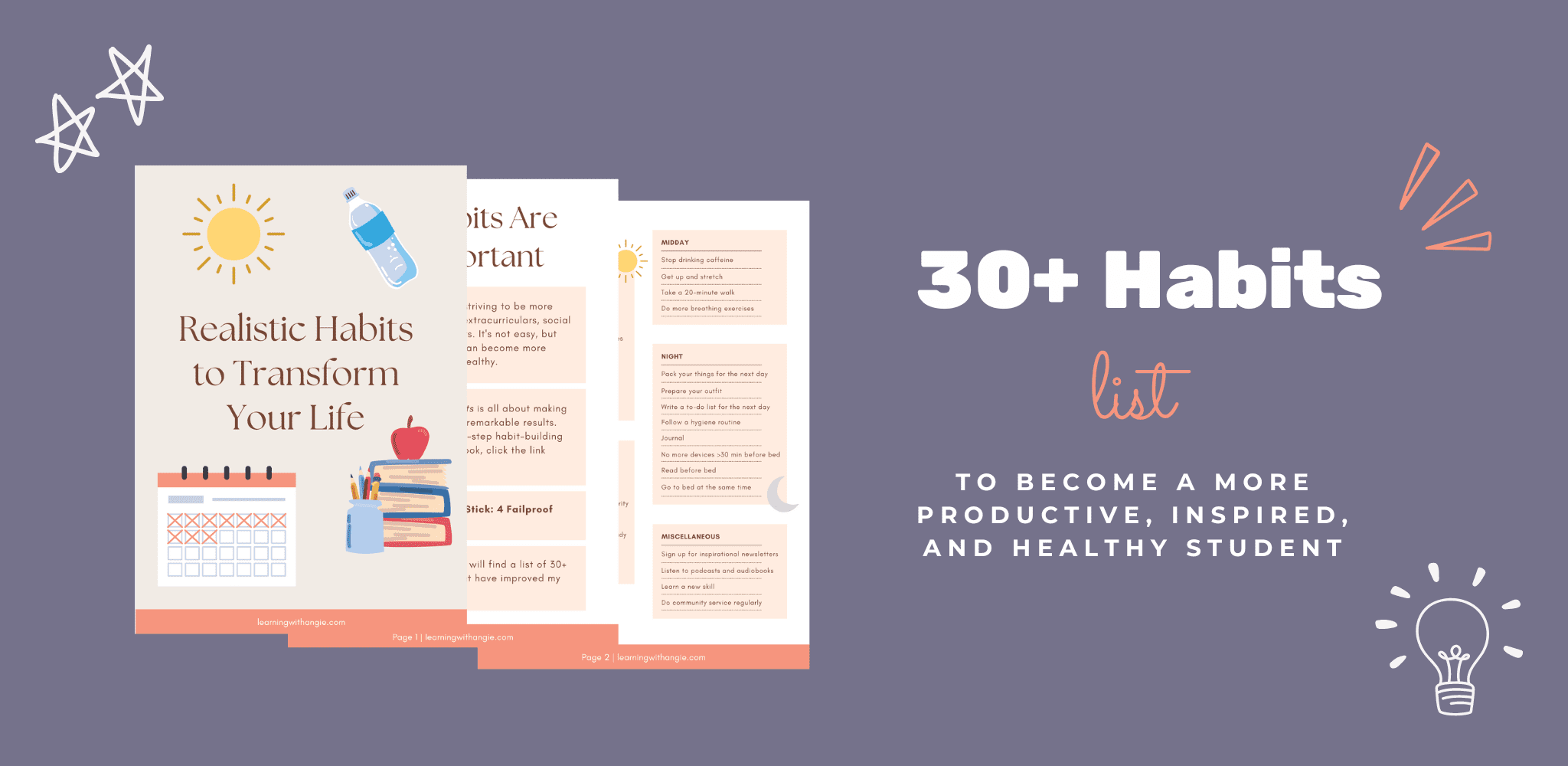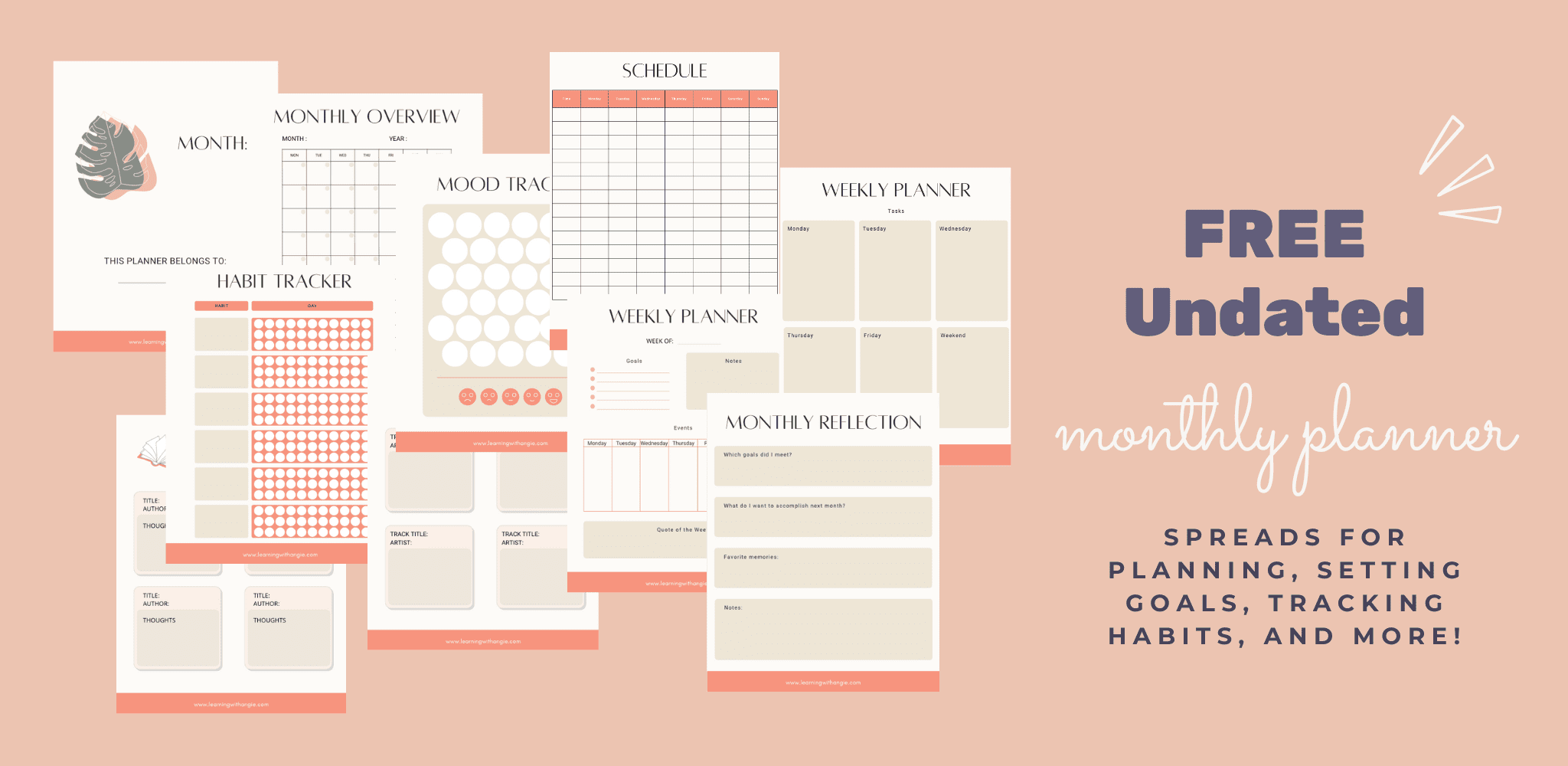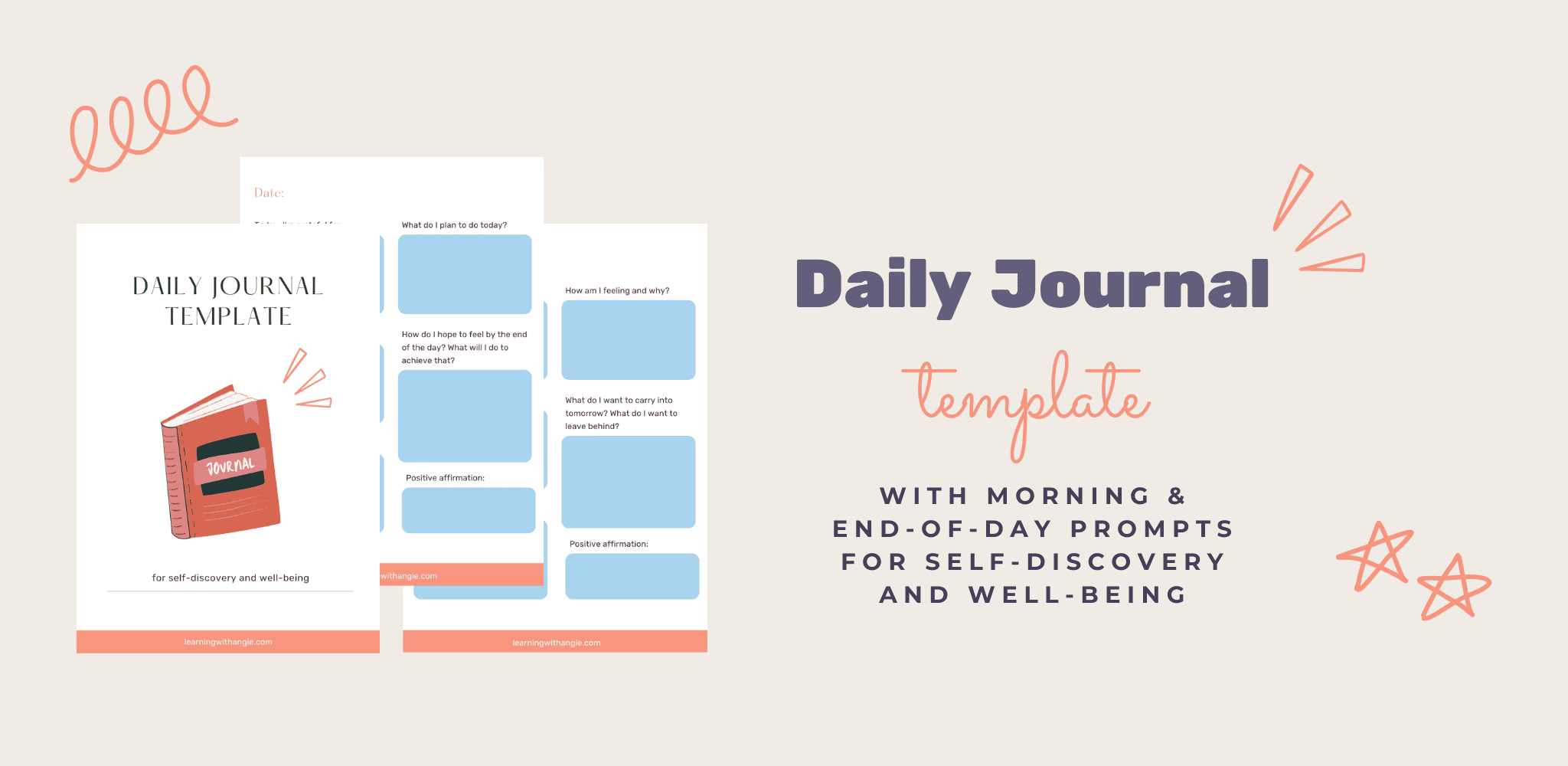

You’ve set goals in the past, like exercising regularly, waking up earlier, or eating healthier. However, these behaviors never seemed to last, and you always reverted to your old habits.
I’ve found myself in a similar dilemma several times. It took me several tries to make working out a habit, to wake up and sleep earlier, and to eat healthier, amongst other healthy habits I wanted to adopt.
But what if I told you that there’s a 4-step method almost guaranteed to help you build habits that stick?
I wouldn’t have believed this before reading James Clear’s Atomic Habits. This book provided me with a new perspective on building self-discipline and achieving new heights through small actions.
In this post, I’ll be summarizing the four steps and providing examples of how I’ve implemented them to build and maintain healthy habits.
This is Part 1 of a two-part series on Atomic Habits, which includes:
- How to build habits that stick
- Applying atomic habits to studying
Let’s dive in!
This post may contain affiliate links, which means that when you make a purchase through a link, I make a small commission at no extra cost to you.
What is Atomic Habits?
Before I get into the bulk of the article, I want to talk briefly about Atomic Habits. If you’re not familiar with the book, it’s about how creating small changes in your life can compound into big results.
Author James Clear provides a simple four-step method to start doing any habit (which can be reversed to break bad habits). Each of the steps addresses one of the following components of building a habit:
- Cue: something that triggers the behavior
- Craving: a desire to repeat the behavior upon sensing the cue
- Response: performance of the behavior
- Reward: a pleasurable consequence that motivates you to repeat the behavior

If any of these components are lacking, a habit will not stick.
If this sounds abstract, here’s a concrete example:
You finish dinner. You usually eat dessert after dinner, so you begin craving something sweet. You satisfy this craving by eating a scoop of Ben and Jerry’s half-baked ice cream (the best flavor). Eating the ice cream is pleasurable, so you repeat the behavior in the future.
Interestingly, the same principles that drive you to eat dessert after dinner can drive you to repeat healthy habits.
If that’s something you want to achieve, I highly recommend reading Atomic Habits.
The book does not fail in its promise to provide a practical, step-by-step guide on building habits that stick.
How Building Habits That Stick Can Change Your Life
Before we get into the four-step process, I want to address the question: what’s the point of committing to the four-step process? Why should you build new habits””and in particular, the atomic habits (tiny changes) that Atomic Habits is all about?
Don’t we need drastic change to see drastic results? Actually, no. And, in fact, drastic change is often not sustainable in the long run.
Ever tried a crash diet? Or suddenly went from sedentary to 30 minutes of high-intensity exercise daily? Or tried implementing a more rigorous study regimen? If so, none of these behaviors probably lasted more than a few days.

If you want to become that person who has their life together“”the one who gets their work done on time, exercises regularly, eats healthy, and still has time for a social life””you can. But, instead of upending your life all at once, you need to take things step-by-step””atomic habit by atomic habit.
Here’s why you should focus on making tiny changes, or adding atomic habits to your routine:
#1: The Benefits of Habits Compound
At the beginning of the book, Clear says:
“If you get one percent better each day for one year, you’ll end up thirty-seven times better by the time you’re done.”
Conversely, if you get 1% worse each day, you’ll end up nearly at zero.

The benefits of good habits compound, just as the consequences of bad ones compound. If you start making positive changes today, you could be an entirely different person not just a year down the road, but a few months.
#2: Your Systems (Habits) >> Your Goals
Setting goals is a fragile thing. You might set the goal to lose X amount of weight or study at least three hours a day, minus the weekend.
But if you set goals without changing your systems (a.k.a. your habits), the positive results you’re seeking won’t be sustainable in the long run.
It’s like Albert Einstein once said (supposedly””one can never put too much trust in the attribution of quotes on the Internet): “Insanity is doing the same thing over and over and expecting different results.”
If you don’t change your systems, you can’t achieve self-growth.
#3: Habits Become Your Identity
We’re often locked down by limiting beliefs that prevent us from starting healthy habits. For example, “I don’t like moving, so I can’t exercise regularly.” Or, “I’m not self-disciplined, so I can’t become a more studious student.”
However, Clear states:
“Your habits shape your identity, and your identity shapes your habits.”
In other words, habits can become your identity. That’s because the behaviors you repeat most frequently provide evidence of the type of person you are.
The person who works out and eats healthy is was not born the “type” of person to lead a healthy lifestyle. However, by turning exercise and conscientious eating into habits, they have become a healthy person.

The student who studies several hours a day is not necessarily the type of person who was born to be more studious. However, by implementing a strict study routine from a young age, being studious has become part of their identity.
You see, the things you do””the habits you choose””form a large part of your identity. And the magic here is that you can choose the things you do by following four simple steps.
Step #1: Make It Obvious
To build habits that stick, the first thing you need to address is the cue””something that triggers the behavior.
According to Clear, there are several ways to accomplish this:
Implementation Intention
Often, we fail to stick to a habit because we don’t specify when or where we want to do it. Therefore, when we’re feeling uninspired or tired, we neglect the habit.
Creating an implementation intention resolves this issue. To create one, you need to specify the time and location you intend to perform a behavior.
With enough repetition, you’ll feel an urge to perform the behavior when the time rolls around. Essentially, the time and location become the cue for the behavior.

Habit Stacking
Integrating a new habit into existing habits is another effective strategy. Using this strategy, the previous habit becomes the cue for the next one.
For example, to get myself to make my bed every morning, I started making my bed right after I got dressed (a habit that was already part of my morning routine). Now, getting dressed is the cue for making my bed. I do it hardly without thinking.
Designing Your Environment
According to Clear, the most self-disciplined people””those who appear to have the most self-control””are usually the ones who need self-control the least. And, no, it’s not because they’re born different. It’s because they prime their environment such that the least amount of self-control is needed to perform good behaviors.
So how can you achieve this? You need to realize that you associate each object in your environment with a behavior. Therefore, you should put objects in your environment that trigger positive behaviors. Also, you shouldn’t associate multiple behaviors with one object.
For example, the only thing I do at my desk is work. If I need to take a break, I get up and move to a different location.

As a result, when I see my desk, my brain automatically associates it with doing work. Objects in your environment can become the cues for desired behaviors.
Step #2: Make It Attractive
The next step in building habits that stick is creating a craving for the habit. You need to make the habit something you want to do, not just something you need to do.
According to Clear, there are several strategies to accomplish this:
Temptation Bundling
This involves associating a new habit with something you already enjoy. You can do so by performing a habit you already enjoy before, after, or even during (if possible) the new habit.
For example, I used to find full-body stretching boring. However, I knew it was important for my muscles and that I should do longer stretching sessions on my rest days.
As a result, I started listening to audiobooks while stretching. Listening to audiobooks was a habit I already enjoyed, so doing it at the same time as stretching made stretching more appealing.

Joining a Positive Community
As humans, we all strive for a feeling of belonging. You can use this to your advantage in building habits that stick.
If you’re trying to build a habit, find a community where: A) that habit is the norm and B) you can relate to the members of the community.
For example, I’ve been playing an instrument almost every day for nearly 15 years of my life. Looking back, I’ve stuck with music because I’ve been immersed in an environment that’s conducive to instrument-playing.
I’ve participated in music camps and competitions, where practicing instruments was common to everyone. The other participants were also amateur musicians””most were school students, not dedicated professionals. As a result, I could relate to them.
Changing Your Mindset
Instead of thinking, “I need to do this,” start thinking, “I get to do this”. This is a simple mindset change, but as I said, Atomic Habits is all about small changes that can compound into remarkable results.
If you’re constantly telling yourself, “I need to do this even though I don’t like it,” you’ll develop a very negative attitude towards the behavior. As a result, you’ll stop performing the behavior on days you lack willpower. After several days in a row, you’ll stop performing the behavior altogether, even if it could provide you with wonderful long-term results.

When I first started strength training, I struggled big time. I could barely lift a five-pound weight, do 10 seconds of bicycle crunches, or hold a 30-second plank. However, I would tell myself things like, “I get to work out to make my body stronger,” instead of, “Why am I putting myself through this pain?”
A mindset change isn’t a one-time change that will solve your problems, however. It’s something you need to repeat to yourself every day.
I still have days where I struggle””days when I don’t want to work out or do a particularly difficult workout. To keep myself going, I repeat the same message: “I get to work out to make my body stronger.”
Creating a Motivation Ritual
A motivation ritual is a short, enjoyable behavior that you perform right before the hard habit.
When I started waking up at 5 am to study, it wasn’t easy. However, listening to music was something I already did to put myself in a good mood.
As a result, I would listen to one or two songs before studying. Now, listening to music before I study in the morning has become a motivation ritual.

Step #3: Make It Easy
The third step in building habits that stick is making the response””the performance of the habit””as easy as possible.
According to Clear, there are several ways to accomplish this:
Focusing on Frequency
You’ve probably heard that it takes 21 days to build a habit. In Atomic Habits, Clear explains that it’s not about the number of days, but the frequency that you perform the behavior.
A habit becomes automatic faster the more frequently you perform it.
In the past, I would reach for caffeine whenever I felt tired. Unfortunately, this disrupted my sleep, and as a result, my overall productivity and well-being.

After watching a few videos on why I felt so tired all the time, I discovered that sitting for too long was a major culprit. So instead of reaching for caffeine, I decided to apply the “more movement provides more energy” concept.
Every time I began to feel tired while working, I would go outside for a short walk. I did this 2-3 times a day. After a walk, I would feel refreshed and energized. Soon, my automatic response to feeling tired while working changed from, “I need caffeine now!” to “I’m going to go out for a walk.”
Reducing Friction
To make a new habit stick, it’s important to remove any obstacles to performing the habit. This means priming your environment to make the habit as effortless to perform as possible.
In high school, I developed the bad habit of watching YouTube before bed as a way to wind down. To replace this habit, I started leaving my tablet outside my room before going to bed. I would also put a stack of books on my nightstand.
Since a book was much easier to reach for than my tablet, reading before bed quickly became a part of my nighttime routine.
The Two-Minute Rule
When you start a habit, it should take no more than two minutes. As the habit becomes automatic, you should scale it up in increments. Ultimately, the goal is to perform the habit you originally intended.
When I first started strength training, I struggled a lot, so I started small.
I didn’t follow the two-minute rule exactly, but I started with 20-minute low-intensity beginner workouts. Over several months, I increased my workout duration by intervals of 10 minutes.
Now, I can do hour-long sessions of strength training five times a week.

The point is that if you start too big, the habit will be an unsustainable struggle. Instead, start with something that only takes two minutes.
Meditate for two minutes a day. Journal for two minutes a day. Read for two minutes a day.
Once those behaviors become easy to perform, scale up.
Step #4: Make It Satisfying
The fourth and final step in building habits that stick is making the behavior rewarding. We only repeat behaviors that bring us pleasure, so this step is just as crucial as the previous three.
According to Clear, there are a few strategies to achieve this:
Creating An Immediate Reward
Most healthy habits have delayed rewards, so you need to create an immediate reward for the habit.
Habit Tracking
Habit tracking is one way to make a behavior immediately satisfying. That’s because checking off the box feels good””you want to keep the chain going.
Plus, habit tracking holds you accountable. Otherwise, you’re likely to have an inaccurate perception of how often you’re performing a habit.
I currently use this all-in-one planner app to track all my habits, such as waking up early, taking my vitamins, and reading.
Other Useful Tips for Building Habits
Apart from the four laws of habit-building, these were my other major takeaways from Atomic Habits:
Get Rid of the All-or-Nothing Mindset
Some days, we just don’t feel like performing a habit. And perhaps, the next day, we still don’t. The problem is that missing one day happens, but once you miss more than that, things start spiraling.
However, it’s important to remember that you don’t have to go all out to perform a habit every day. Sometimes, just showing up is all that matters.
Some days, I don’t feel like working out. However, instead of letting a workout slide, I’ll do a short 10-minute cardio session, a full-body stretch, or some calming yoga. It doesn’t matter that I don’t complete a full workout. What matters is that I show up.
Reflect and Revise
When habits become automatic, we stop thinking about them””the steps we go through to perform them and the benefits we reap from them.
This means that to improve, you must reflect on your habits and scale them up. For example, say you want to read more. You can start with two minutes a day (according to the two-minute rule), then scale up to five minutes, ten minutes, 20 minutes, and so on, so forth.
Journaling is a great way to become more aware of your habits and your progress. However, you don’t need to reflect on your habits daily.

Instead, I find it useful to do monthly reflections. I make a list of my habits and note how consistent I’ve been and whether they’ve been providing the benefits I want. Then, I plan ways to scale them up.
With monthly reflections, you have tangible evidence of your growth at the end of each month.
Overview of How to Build Habits That Stick
Building small habits can completely transform your life. Perhaps the results won’t be obvious in the short term, but in the long term, small changes compound into remarkable results (remember 1% improvement daily = 37x better by the end of the year!).
There are four crucial steps to build habits that stick:
- Make it obvious: Use implementation intention, habit stacking, and environment priming to create an obvious cue for the behavior.
- Make it attractive: Use temptation bundling, join a supportive community, adopt a positive mindset, or implement a motivation ritual to create a craving to perform the behavior.
- Make it easy: Focus on frequency, reducing friction, and applying the two-minute rule to make the response (performing the behavior) as effortless as possible.
- Make it satisfying: Create an immediate reward and use habit tracking to make a behavior rewarding.

In addition to implementing these four steps, it’s important to:
- Let go of the all-or-nothing mindset. Some days, you won’t feel like performing the habit. However, it’s important to remember that you don’t need to go all out on the habit for it to count. Some days, just showing up is enough.
- Reflect and revise. Once habits become automatic, we think less about how we perform them and whether they’re benefiting us. Therefore, it’s important to regularly reflect on our habits and adjust them to maintain self-growth.
And finally, if you enjoyed this post, I highly recommend getting your own copy of James Clear’s Atomic Habits. In addition to the four steps of habit-building, he delves into:
- The psychological motivations for performing behaviors. This helped me gain clarity on why certain strategies work and why others don’t.
- How to break bad habits. He explains exactly how to use the four laws to do the reverse of building a habit””breaking a habit.
- Lots of creative examples on implementing the four laws to build good habits and break bad ones.
- How our individual personalities affect the habits we should choose.
Overall, Atomic Habits showed me that small changes can lead to drastic results. If we implement the right systems, we can achieve so much more than we can imagine.
I hope this article inspired you to start making positive changes in your life. What habits do you want to start? How will you be applying the four steps to build habits that stick in the long run? Let me know in the comments below!
(If you’re not sure which habits to start, make sure to download this list of 30+ habits to improve your productivity and well-being as a student!)
Lastly, for more posts on self-improvement, check out:

Learning With Angie is a place to share honest, unfiltered advice to promote student success. So if you’re a student (high school, college, or beyond) looking for tips on productivity, studying, personal growth, and more to reach your potential, this is the place! To read more about Learning with Angie, click here.




















